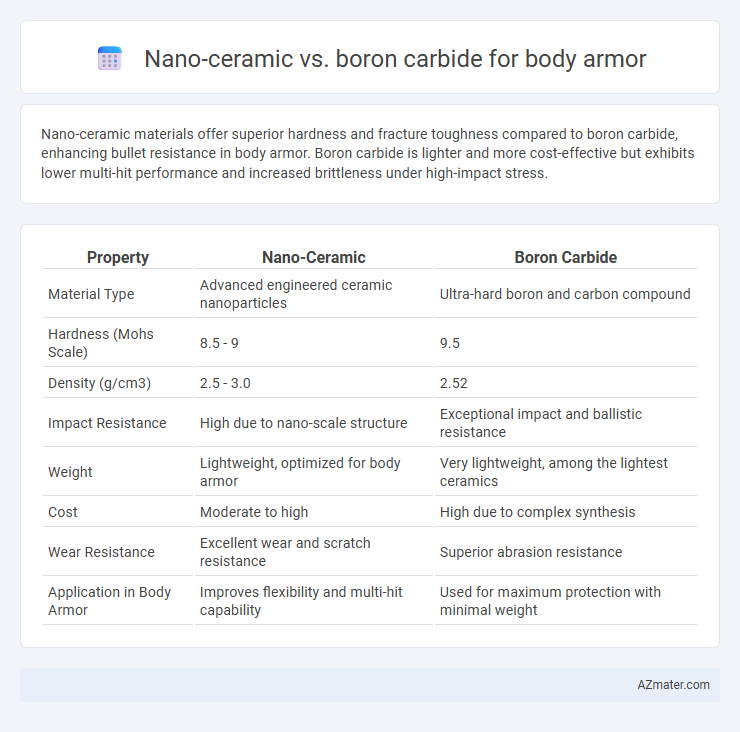Nano-ceramic materials offer superior hardness and fracture toughness compared to boron carbide, enhancing bullet resistance in body armor. Boron carbide is lighter and more cost-effective but exhibits lower multi-hit performance and increased brittleness under high-impact stress.
Table of Comparison
| Property | Nano-Ceramic | Boron Carbide |
|---|---|---|
| Material Type | Advanced engineered ceramic nanoparticles | Ultra-hard boron and carbon compound |
| Hardness (Mohs Scale) | 8.5 - 9 | 9.5 |
| Density (g/cm3) | 2.5 - 3.0 | 2.52 |
| Impact Resistance | High due to nano-scale structure | Exceptional impact and ballistic resistance |
| Weight | Lightweight, optimized for body armor | Very lightweight, among the lightest ceramics |
| Cost | Moderate to high | High due to complex synthesis |
| Wear Resistance | Excellent wear and scratch resistance | Superior abrasion resistance |
| Application in Body Armor | Improves flexibility and multi-hit capability | Used for maximum protection with minimal weight |
Introduction to Advanced Body Armor Materials
Nano-ceramic and boron carbide represent cutting-edge materials in advanced body armor technology, renowned for their exceptional hardness and lightweight properties. Nano-ceramic composites offer enhanced impact resistance through ultra-fine grain structures that improve energy dispersion during ballistic impacts. Boron carbide, one of the hardest known ceramics, provides superior protection against armor-piercing rounds while maintaining low density, making it ideal for lightweight personal protective equipment.
Nano-Ceramic Body Armor: Composition & Properties
Nano-ceramic body armor is primarily composed of nanoscale ceramic particles such as silicon carbide or alumina that significantly enhance hardness and fracture toughness, offering superior ballistic resistance with reduced weight. The nanostructured particles create an exceptionally hard surface that effectively disperses the energy from projectiles while maintaining lightweight and flexibility when integrated with composite backing materials. This composition results in armor that provides improved durability, higher impact resistance, and better multi-hit performance compared to traditional ceramic armor materials like boron carbide.
Boron Carbide Body Armor: Composition & Properties
Boron carbide body armor is composed primarily of boron carbide (B4C), a ceramic material renowned for its exceptional hardness, ranking third after diamond and cubic boron nitride. Its low density (about 2.52 g/cm3) ensures lightweight protection, while its high compressive strength and extreme resistance to impact and abrasion make it ideal for ballistic applications. These properties enable boron carbide armor to offer superior protection against high-velocity projectiles, outperforming many other ceramics including nano-ceramics in multi-hit scenarios.
Weight Comparison: Nano-Ceramic vs Boron Carbide
Nano-ceramic materials typically offer a lighter weight alternative to boron carbide in body armor applications, enhancing mobility without compromising protection. Boron carbide, while exceptionally hard and effective against high-velocity projectiles, generally exhibits a higher density, resulting in heavier armor plates. Weight comparison reveals nano-ceramic composites reduce wearer fatigue and improve endurance during extended use due to their lower mass-to-protection ratio.
Ballistic Performance and Protection Levels
Nano-ceramic materials in body armor offer superior hardness and light weight, providing high ballistic resistance against rifle rounds while maintaining comfortable wearability. Boron carbide, known for its exceptional hardness and low density, delivers excellent multi-hit protection with enhanced shattering resistance, making it ideal for high-threat ballistic threats. The choice between nano-ceramic and boron carbide depends on balancing required protection levels, impact absorption, and weight constraints in armor design.
Durability and Multihit Resistance
Nano-ceramic body armor offers superior hardness and lightweight properties, providing enhanced durability against high-velocity projectiles while maintaining structural integrity over multiple impacts. Boron carbide armor exhibits exceptional multihit resistance due to its high fracture toughness and ability to disperse energy across the ceramic matrix, making it ideal for sustained ballistic protection. Both materials deliver robust protection, but boron carbide typically outperforms nano-ceramics in scenarios requiring repeated ballistic impacts without significant armor degradation.
Cost Analysis: Affordability and Value
Nano-ceramic materials used in body armor offer a balance of high hardness and lightweight properties at a relatively moderate cost, making them a cost-effective choice for mass production and large-scale deployment. Boron carbide, while providing superior hardness and ballistic protection, comes with a significantly higher price due to its complex manufacturing process and raw material scarcity. The value of nano-ceramic lies in its affordability combined with adequate protection, whereas boron carbide is favored in scenarios where maximum defense justifies the premium expense.
Comfort and Ergonomics for Wearers
Nano-ceramic body armor offers enhanced comfort and better ergonomics due to its lighter weight and improved energy dispersion, reducing wearer fatigue during extended use. Boron carbide, while highly durable and protective, tends to be heavier and more rigid, which can limit mobility and cause discomfort over prolonged periods. The superior flexibility and reduced bulk of nano-ceramic plates make them preferable for applications prioritizing wearer comfort and agility.
Field Performance and Real-World Applications
Nano-ceramic armor offers superior hardness and fracture toughness compared to boron carbide, resulting in enhanced multi-hit capability and reduced weight for ballistic protection. Boron carbide excels in stopping high-velocity threats due to its exceptional hardness and is widely used in military-grade body armor for infantry and vehicle protection. Field performance data shows that while nano-ceramic composites provide better durability in repeated impact scenarios, boron carbide remains preferred for applications requiring maximum penetration resistance against armor-piercing rounds.
Future Trends in Body Armor Technology
Future trends in body armor technology emphasize the integration of nano-ceramic composites due to their superior hardness-to-weight ratio and improved energy absorption compared to traditional boron carbide ceramics. Innovations in nano-ceramic materials enable enhanced ballistic protection with reduced armor weight, increasing soldier mobility and comfort. Research focuses on hybrid armor systems combining nano-ceramics with boron carbide to achieve optimal balance between cost-efficiency, durability, and multi-threat resistance.

Infographic: Nano-ceramic vs Boron carbide for Body armor
 azmater.com
azmater.com